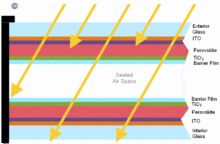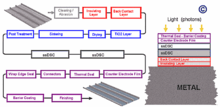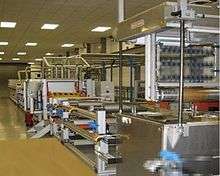Dyesol
Dyesol (ASX: DYE, FWB: D5I, OTCQX: DYSOY) is a solar energy company developing solid-state Dye Solar Cell (DSC) technology, known as Perovskite dye solar cells, for Building Integrated Photovoltaic (BIPV) applications. The company develops DSC chemicals, components and equipment, and assists manufacturing partners to produce photovoltaic modules. The company is based in Queanbeyan, Australia and opened its manufacturing and research facilities in October 2008. It has expanded to several locations around the world, including the UK and Switzerland, as has established joint ventures in South Korea, Germany and Singapore.
DSC technology was invented at the Institute of Physical Chemistry, Swiss Federal Institute of Technology in Lausanne, Switzerland in 1988 by Brian O'Regan and Michael Graetzel. Their paper A low-cost, high-efficiency solar cell based on dye-sensitized colloidal TiO2 films, published in 1991 in the journal, Nature, was the catalyst that spawned a whole new industry and a whole new way of looking at harvesting electrical power from sunlight. Since that time Professor Graetzel, now at Switzerland's École Polytechnique Fédérale de Lausanne (EPFL), has remained strongly focused on DSC technology, received numerous awards and accolades in relation to the invention of DSC, and maintained close links to Dyesol as Chairman of Dyesol's Technical Advisory Board.
From 1994, STI and Greatcell teams in Australia and Switzerland further developed DSC technology and established the world's first DSC prototype manufacturing facility in Australia in 2000. Key to that development phase was the invention of processes, new materials, and equipment to manufacture DSC products. Dyesol acquired the laboratory, manufacturing equipment and intellectual property which has resulted in a portfolio of patents that Dyesol before mid-2005. Dyesol acquired STI in 2006 and Greatcell in 2007.
Dyesol Limited was formed in 2004 to accelerate the commercial development of Dye Solar Cell technology and build on the DSC work of previous 14 years carried out by Sustainable Technologies International Pty Ltd ("STI"), Greatcell Solar S.A. ("Greatcell"), and Switzerland's École Polytechnique Fédérale de Lausanne (EPFL). It was listed on the Australian Stock Exchange in 2005 (DYE) and the German Open Market (D5I.F), and is trading on the OTCQX (DYSOY) through its depositary BNY Mellon.
In May 2013 Dyesol announced that Dye Solar Cell (DSC) technology has achieved a technical breakthrough by achieving a solid-state DSC (ss-DSC) efficiency of 11.3% at full sun. At this level of module performance the technology will be grid competitive - the "Holy Grail" for renewable energy technologies.

This achievement is particularly important in solar markets where Light Conditions are sub-optimal, such as Europe, North America and North-East Asia, where Dyesol ssDSC technology has a considerable advantage over 1st and 2nd generation photovoltaic technologies.
Dyesol has been working closely with R&D partner, the EPFL, and is confident of announcing further improvements in solid-state performance in the near term. Remarkably, Perovskite solid-state DSC (ssDSC) performance is confidently expected to outperform all hitherto known and published 1st and 2nd generation Photovoltaic Cells.

On July 11, 2013 Dyesol /EPFL announced a new record DSC efficiency. Michael Grätzel stated ”Our research work on solid-state Dye Solar Cells (ss-DSC) is now achieving efficiencies exceeding 15% .
Currently, the official accredited World Record Efficiency is 14.1% however efficiencies exceeding 15% are being achieved in the laboratory using perovskites , and experts are forecasting well beyond 20% as achievable not too distantly".
Dye Solar Cell Technology
DSC technology can best be described as 'artificial photosynthesis' using an electrolyte, a layer of titania (a pigment used in white paints and tooth paste) and ruthenium dye deposited on glass, metal or polymer substrates.

The term mesoscopic has been introduced to reflect further advances in the technology, particularly where a perovskite is substituted for dye as a sensitiser. Light striking the sensitiser excites electrons which are absorbed by the titania to become an electric current.
Compared to conventional silicon based photovoltaic technology, Dyesol's technology has lower cost and embodied energy in manufacture, it produces electricity more efficiently even in low light conditions and can be directly incorporated into buildings by replacing conventional glass panels or metal sheets rather than taking up roof or extra land area. .
Solid State Dye Solar Cell Technology (ssDSC)

A new two-step deposition process to create the light harvesting pigment for solid-state dye solar cells.
Cells fabricated using this technique and incorporating Dyesol’s key DSC input materials and specially formulated 18NR-T Titania Paste have established a new world record efficiency of 18% for a solid-state Dye Solar Cell (ssDSC).
ssDSC Technology is in the R&D phase of development and not yet available for purchase in the mass market. However, Dyesol currently produces high purity sensitising dyes; titania pastes & platinum pastes; electrolytes; sealants for use in flexible and rigid devices; substrates and silver Inks.
.
Subsidiaries and Partnerships

Subsidiaries
- Dyesol-Timo Co Ltd ( ssDSC & Liquid DSC on Glass / Polymers / Steel ) South Korea
- Dyesol Automotive Bavaria GmbH ( ssDSC & Liquid DSC for Automotive) Germany
- Dyesol-Printed Power Pte Ltd (Research into Combined Energy Generation and Storage (CEGS) . Singapore
Academic and R&D Partners
- EPFL On going Research mainly into Solid State DSC (ssDSC). Switzerland
- Nanyang Technological University Research into Solid State DSC (ssDSC) Singapore
- CSIRO Research into Solid State DSC (ssDSC) Australia
- Australian Nuclear Science_and Technology Organisation ANSTO Australia
- Bangor University
- University of Sheffield
- University of Manchester
- Swansea University
- SPECIFIC Wales
- AkzoNobel Performance Coatings
- TATA Steel Europe Colorcoat Steel Roofing & Siding
- BASF Chemicles
- Alcro-Beckers AB Paint
- Nippon Sheet Glass Glass
- EPSRC
- Innovate UK
Commercial Partners
- Merck KGaA ( Supplying electrolytes,Ionic liquids )
- Sigma-Aldrich (Global Distribution of DSC and ssDSC Materials)
- TASNEE ( Assistance with future funding and guarantees ) Saudi Arabia
- Cristal ( Supplying Nano-Titania for use by Dyesol partners ) Saudi Arabia
Suppliers
- Sefar AG Supplying transparent conducting film for use by Dyesol partners
- Pilkington Supplying Transparent Conductive Oxides (TCO) for use by Dyesol partners
- Umicore Supplying liquid DSC Dyes for use by Dyesol partners
- SIA Engineering Company/Meerkat Manufacturing facilities for use by Dyesol Partners
Industrial Consumers
- G24 Innovations Ltd. ( Dyes )
- Nesli DSC ( Turkey )
Distribution
- TATA Steel Europe Colorcoat Steel Roofing & Siding
- .
.
See also
External links
- Dyesol
- DYESOL AND SINGAPORE’S NTU SIGN AGREEMENT
- Dyesol and Printed Power Singapore Entering a New Market CEGS
- DYESOL ACHIEVES TECHNICAL BREAKTHROUGH IN SOLID STATE DSC (ssDSC)
- NTU scientists make breakthrough using ssDSC Technology
- Science Magazine:- Newcomer Juices Up the Race to Harness Sunlight
- Growing Demand for Green Energy Solutions to Drive the Market for ssDSC
- Turkey Takes Important DSC Commercialisation Steps
- Dyesol and CSIRO working together to advance the scale-up of ssDSC
- Dyesol Limited has signed a Global Distribution Agreement with Sigma-Aldrich® Corporation
- Cheaper Perovskite could replace Silicon in Solar Cells
- PVTEC :- Dyesol mulling pilot line phases for perovskit thin-film products
- 2-DTech & Dyesol secures grants for Innovation
- 27 Nov 2014 Annual General Meeting